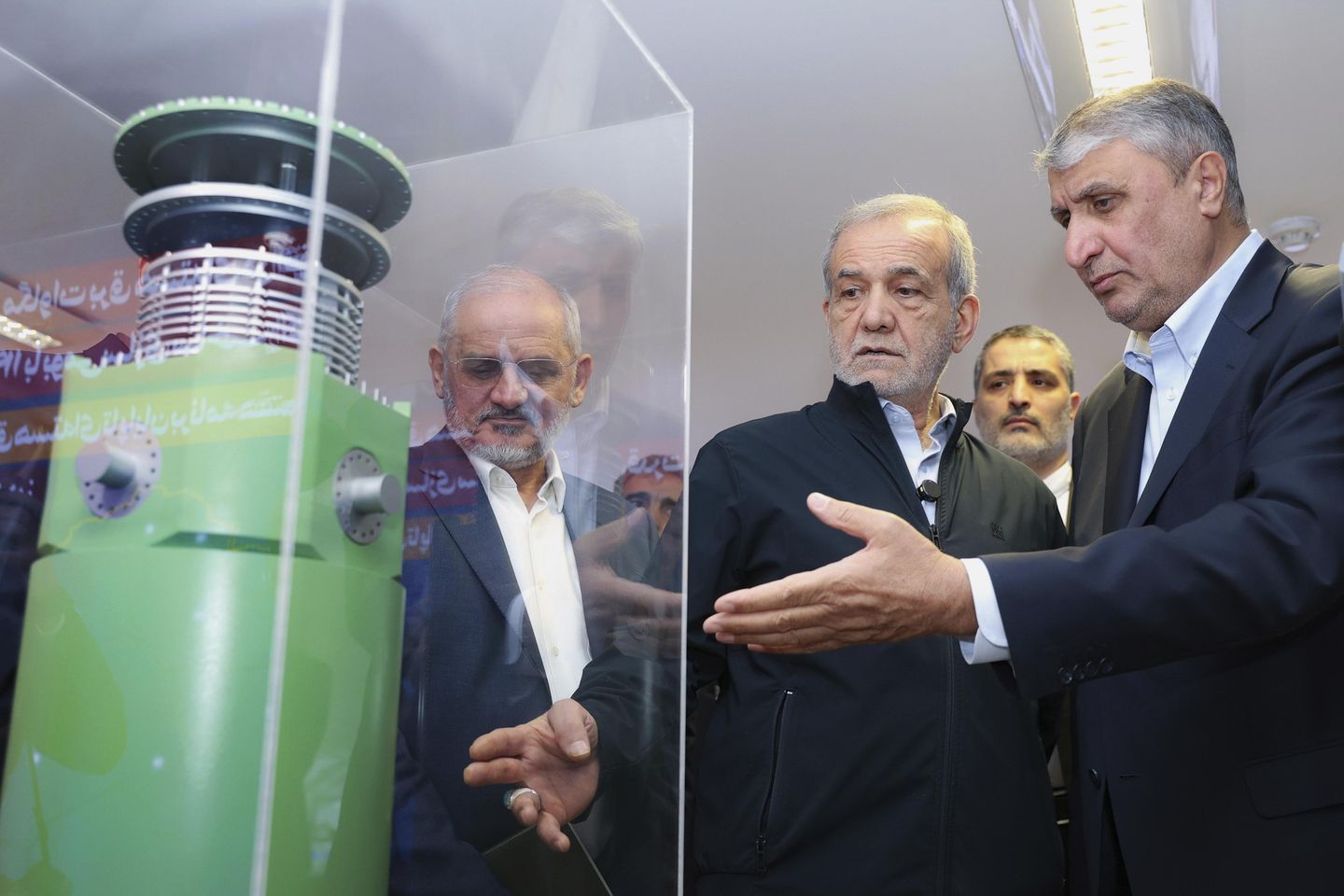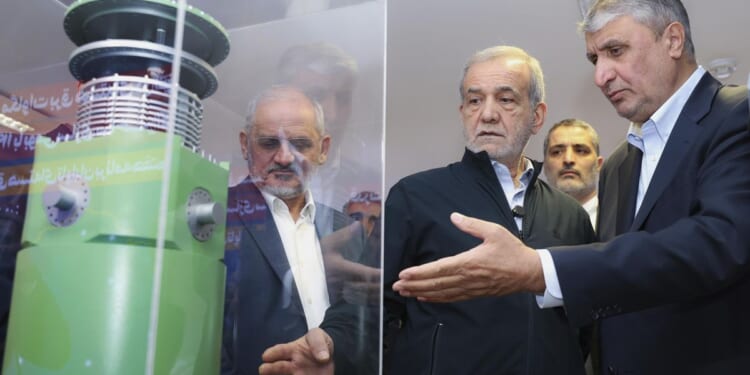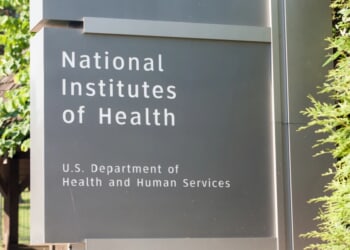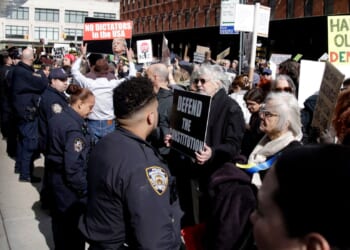
The Trump administration will enter direct nuclear negotiations with Iran this weekend with a seemingly endless list of high-stakes questions in play: For starters, will the U.S. push for the full dismantlement of Iran’s plutonium production and uranium enrichment programs, or accept something short of that?
Should the Trump administration roll back Iran’s ballistic missile program? Is Tehran’s financial support for terrorist groups such as Hamas, Hezbollah and the Yemen-based Houthi rebels on the table? Or its provision of drones to Russia for its war in Ukraine?
And could the White House aim for a deal so sweeping — perhaps with highly lucrative financial incentives through the lifting of sanctions and potential U.S. investment in Iran — that it could chip away at Tehran’s deepening military and economic alignment with Russia, China and North Korea as part of the so-called “axis of authoritarians?”
Heading into Saturday’s U.S.-Iran talks in Oman, foreign policy analysts are split on what kind of agreement President Trump can secure, how aggressive he should be with his goals, and whether engaging with Tehran’s theocratic regime is a worthwhile endeavor at all. So far, there’s little in the way of a clear framework guiding the negotiations, other than this core principle: The administration insists Iran cannot and will not acquire a nuclear bomb.
For Mr. Trump personally, it’s another opportunity for the kind of outside-the-box diplomacy that he relishes. No matter how thorny the issue, or even how distasteful the actors sitting on the other side of the table, the president has repeatedly demonstrated a willingness to talk to adversaries and shown a belief that he, more than any other leader in the free world, can make monumental deals on the most complex and dangerous of geopolitical playing fields.
In this case, some specialists say that in a best-case scenario Mr. Trump will have to accept a limited deal, one that constrains Iran’s nuclear program but keeps some economic sanctions in place because Tehran will likely be unwilling to end its material support for terrorist groups.
“I would leave missiles out but try to maximize restraints on all nuclear activities permanently in exchange for lifting of most sanctions,” said Michael O’Hanlon, senior fellow and director of research in foreign policy at the Brookings Institution.
“It would be ideal to limit [or] stop terrorism but that may be a bridge too far. Hence the likely need to retain some sanctions even in a very good deal on the nukes,” he told The Washington Times.
Underscoring the uncertainty, it’s not even clear what the talks themselves will look like. Mr. Trump has said that his Middle East envoy, Steve Witkoff, would meet face to face with Iranian Foreign Minister Abbas Araghchi.
“A lot of people say, ’Oh, maybe you’re going through surrogates, or you’re not dealing directly. You’re dealing through other countries.’ No, we’re dealing with them directly,” Mr. Trump said earlier this week.
But Iranian officials have said they’d prefer indirect talks, which would likely involve an Omani delegation acting as go-betweens for the U.S. and Iranian sides. The White House reportedly is considering postponing the talks if Tehran doesn’t agree to direct, face-to-face negotiations.
The Trump administration also is flexing its muscles ahead of the meeting. The Treasury on Wednesday announced fresh economic sanctions targeting five entities and one individual that procure or manufacture technologies related to Iran’s nuclear program, the administration said.
How far to push?
Mr. Trump has made clear, both with Iran and in other talks with U.S. adversaries such as North Korea and Russia, his deep desire to solve major crises through dealmaking. He kickstarted negotiations with Iran by sending a March letter directly to Iranian Supreme Leader Ayatollah Ali Khamenei.
It was a remarkable step by both historic and personal standards: The U.S. hasn’t had direct diplomatic relations with Iran since 1980. And during Mr. Trump’s first term, the two countries nearly went to all-out war after a U.S. airstrike killed Iranian Gen. Qassem Soleimani, the former head of Iran’s Islamic Revolutionary Guard Corps and a key figure in Iran’s “axis of resistance,” its network of deadly proxy groups across the Middle East.
To justify this round of diplomatic outreach, Mr. Trump will need to show a much stronger deal than the one struck by former President Barack Obama, the 2015 pact known as the Joint Comprehensive Plan of Action, or JCPOA.
During his first term, Mr. Trump pulled the U.S. out of that agreement, arguing that it did not go far enough to rein in Iran’s nuclear program, left open pathways for Iran to acquire a bomb and did not address Tehran’s decades-long support for terrorist groups targeting the U.S. and Israel, among other deficiencies.
But since then, Iran has expanded its support for terror groups, including Hamas, which attacked Israel in 2023, and Yemen’s Houthi rebels, which have targeted commercial and U.S. military ships in the Red Sea over the past 18 months.
Tehran also is accelerating its nuclear program. Analysts generally agree that Iran is racing ahead with its uranium enrichment efforts to the point that it could build a nuclear weapon in a matter of days.
Iran’s ballistic missile program, too, has seen dramatic expansion. It is now believed to have an arsenal of over 3,000 such weapons.
All of those elements could be on the table in upcoming talks. Some scholars argue that the U.S. should insist that Iran end its military support for Russia and immediately stop any nuclear and missile cooperation with China, Russia, North Korea, and other American adversaries.
In a recent comprehensive analysis, researchers at the Foundation for Defense of Democracies also argued that Iran’s access to nuclear fuel should be all but eliminated, and that the International Atomic Energy Agency must have unprecedented access to the country.
“Iran must allow the full, permanent, and verifiable dismantlement, export, or in-place destruction of its uranium, plutonium, and heavy water production assets and associated equipment; verified strict limitations on the import of reactor fuel to run permitted research reactors; required export of spent reactor fuel; the permanent and verifiable prohibition on Iran’s reconstitution of uranium conversion and enrichment and plutonium production and reprocessing capabilities; and permanent IAEA monitoring of Iran’s uranium mines, mills, and ore processing facilities and activities,” reads the analysis, written by FDD Senior Fellow Orde Kittrie, Iran Program Senior Director Behnam Ben Taleblu and Nonproliferation and Biodefense Program Deputy Director Andrea Stricker.





![Jasmine Crockett Justifies Mass Illegal Immigration With Bizarre Argument [WATCH]](https://www.right2024.com/wp-content/uploads/2025/03/1742007023_Jasmine-Crockett-Justifies-Mass-Illegal-Immigration-With-Bizarre-Argument-WATCH-350x250.jpg)

![NYC Tourist Helicopter Falls into Hudson River, Siemens Executive and Family Among Those Killed [WATCH]](https://www.right2024.com/wp-content/uploads/2025/04/NYC-Tourist-Helicopter-Falls-into-Hudson-River-Siemens-Executive-and-350x250.jpg)








